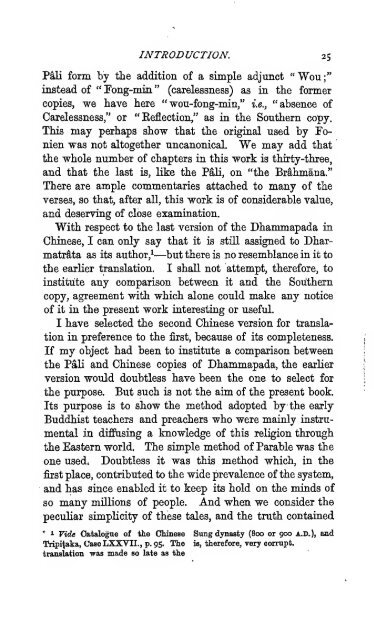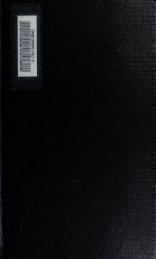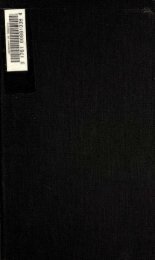Texts from the Buddhist canon : commonly known as Dhammapada
Texts from the Buddhist canon : commonly known as Dhammapada
Texts from the Buddhist canon : commonly known as Dhammapada
Create successful ePaper yourself
Turn your PDF publications into a flip-book with our unique Google optimized e-Paper software.
INTRODUCTION. 25<br />
Pali form by <strong>the</strong> addition of a simple adjunct "Wou;"<br />
instead of " Fong-min " (carelessness) <strong>as</strong> in <strong>the</strong> former<br />
copies, we have here " wou-fong-min," i.e., "absence of<br />
Carelessness," or "Eefiection," <strong>as</strong> in <strong>the</strong> Sou<strong>the</strong>rn copy.<br />
This may perhaps show that <strong>the</strong> original used by Fo-<br />
nien w<strong>as</strong> not altoge<strong>the</strong>r un<strong>canon</strong>ical. We may add that<br />
<strong>the</strong> whole number of chapters in this work is thirty-three,<br />
and that <strong>the</strong> l<strong>as</strong>t is, like <strong>the</strong> Pali, on "<strong>the</strong> Br§,hmana."<br />
There are ample commentaries attached to many of <strong>the</strong><br />
verses, so that, after all, this work is of considerable value,<br />
and deserving of close examination.<br />
With respect to <strong>the</strong> l<strong>as</strong>t version of <strong>the</strong> <strong>Dhammapada</strong> in<br />
Chinese, I can only say that it is still <strong>as</strong>signed to Dhar-<br />
matr§,ta <strong>as</strong> its author,'— ^but <strong>the</strong>re is no resemblance in it to<br />
<strong>the</strong> earlier translation. I shall not attempt, <strong>the</strong>refore, to<br />
institute any comparison between it and <strong>the</strong> Sou<strong>the</strong>rn<br />
copy, agreement with which alone could make any notice<br />
of it in <strong>the</strong> present work interesting or useful.<br />
I have selected <strong>the</strong> second Chinese version for transla-<br />
tion in preference to <strong>the</strong> first, because of its completeness.<br />
If my object had been to institute a comparison between<br />
<strong>the</strong> Pali and Chinese copies of <strong>Dhammapada</strong>, <strong>the</strong> earlier<br />
version would doubtless have been <strong>the</strong> one to select for<br />
<strong>the</strong> purpose. But such is not <strong>the</strong> aim of <strong>the</strong> present book.<br />
Its purpose is to show <strong>the</strong> method adopted by <strong>the</strong> early<br />
<strong>Buddhist</strong> teachers and preachers who were mainly instrumental<br />
in diffusing a knowledge of this religion through<br />
<strong>the</strong> E<strong>as</strong>tern world. The simple method of Parable w<strong>as</strong> <strong>the</strong><br />
one used; Doubtless it w<strong>as</strong> this method which, in <strong>the</strong><br />
first place, contributed to <strong>the</strong> wide prevalence of <strong>the</strong> system,<br />
and h<strong>as</strong> since enabled it to keep its hold on <strong>the</strong> minds of<br />
so many millions of people. And when we consider <strong>the</strong><br />
peculiar simplicity of <strong>the</strong>se tales, and <strong>the</strong> truth contained<br />
' i Vide Catalogue of <strong>the</strong> Chinese Sung dyn<strong>as</strong>ty (800 or 900 A.D.), and<br />
Tripitaka, C<strong>as</strong>e LXXVII., p. 95. The is, <strong>the</strong>refore, very corrupt,<br />
translation Tr<strong>as</strong> made so late <strong>as</strong> <strong>the</strong>





